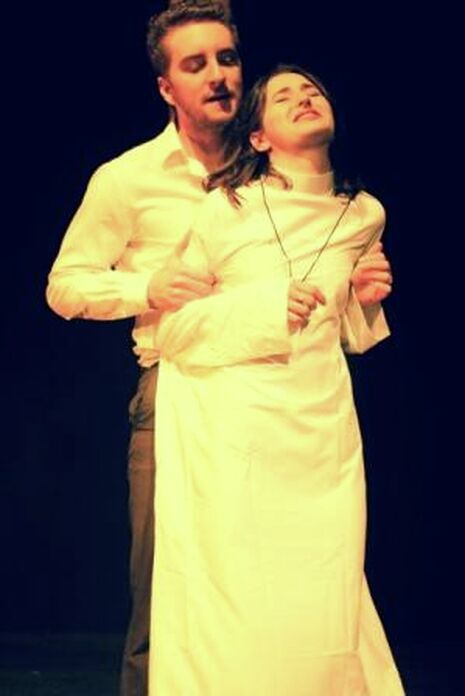Review: The White Devil
‘A dynamic, action-packed, and highly politicised adaptation’

I left to watch the ADC’s performance of The White Devil, feeling fairly convinced that a play centred around blood, sex, and politics would prove to be an enjoyable way to kill an evening. The ADC did not disappoint, and I was provided with a dynamic, action-packed, and highly politicised adaptation of Webster's harrowing revenge tragedy.
Before the performance began, the audience was met with an interesting stage set-up, which featured a large crucifix suspended from the ceiling, and an Orthodox priest stood up in a high platform towards the back of the stage. The effect created was an imposing sense of theocratic power, and the contrast of light and dark on the stage generated the atmosphere of secrecy and obscurity in which the rest of the action takes place. The high level at the back suggested the powers that be behind and above, occasionally made visible in instances such as the instillation of the patriarch, but it was a narrow platform, leaving plenty of room for the sordid business that these "higher" characters lowered themselves to on the stage below. The smaller stage of the ADC recaptured one of the structurally expressive resources of the Jacobean theatre.
There were some strong performances, especially from some of the female players. Vittoria was played with a fascinating degree of insight and emotional intelligence, and her actions and emotions were nuanced and dynamic enough to provoke sympathy, whilst also creating moments of triumph. This came across in one of Vittoria’s most crucial scenes, her trial, where she successfully portrayed a maelstrom of emotions which shifted from the audience pitying her assault from the patriarchy, whilst ultimately sharing in her triumph at the end of the scene. Isabella was then the most interesting interpretation of her character I have seen, and what was notable in her, and in Vittoria’s, performance, was the use of emotional restraint in order to align the audience with the plight of women under the patriarchy. Other strong performances include Cordelia, who delivered a powerfully emotive performance, and Flamineo, whose energy and comic timing made him a compelling malcontent. The acting and directing demonstrated that the company had thought not just about the lines, but the situations motivating the lines, and so it came over with real force and clarity.
One of the most engaging aspects of this production was the creation of uncomfortable or awkward scenes. These included scenes where Flamineo would look straight into the audience, stony-faced, whilst expounding a heavily misogynistic dialogue, or the uncomfortable boundaries of consent that exist within such unbalanced male-female relationships. Although the lighting and sound could have been made more of, this is perhaps understandable in the early stages of a production. It was also evident at points of the play that more work was needed to perfect some scenes, which will surely improve on the subsequent nights. The second part of the first half lost some of the force and momentum, and yet this is also an issue with the text itself, and the second half picked up to be much more engaging.
My favourite moment of the play would have to be the moment where the bed collapsed under the weight of Bracciano and Lodovico during Bracciano’s death scene (unintentionally symbolic of the moral collapse of society?) which produced irrepressible giggles from most of the audience.
Overall, a strong and engaging production, well worth a watch.
 Features / How sweet is the en-suite deal?13 January 2026
Features / How sweet is the en-suite deal?13 January 2026 Comment / Will the town and gown divide ever truly be resolved?12 January 2026
Comment / Will the town and gown divide ever truly be resolved?12 January 2026 News / 20 vet organisations sign letter backing Cam vet course13 January 2026
News / 20 vet organisations sign letter backing Cam vet course13 January 2026 Arts / Fact-checking R.F. Kuang’s Katabasis13 January 2026
Arts / Fact-checking R.F. Kuang’s Katabasis13 January 2026 Music / Inside Radiohead’s circle13 January 2026
Music / Inside Radiohead’s circle13 January 2026








